一个轻巧高效的多线程c++stream风格异步日志(二)
一个轻巧高效的多线程c++stream风格异步日志(二)
前言
本文紧接上一篇文章: 介绍上文中的一条条日志是如何异步导入本地文件的.
首先会简单介绍下LogFile类,之后会具体讲解下AsyncLogging中的双缓冲机制.
整个日志模块的结构图,
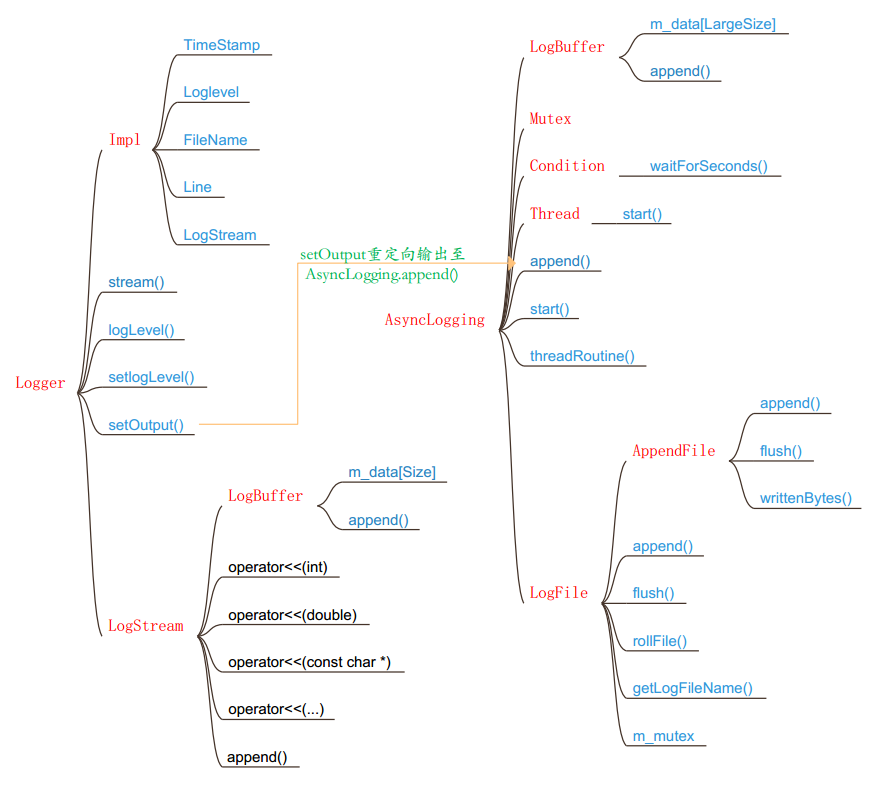
LogFile类
LogFile日志文件类 完成日志文件的管理工作.
rollFile() :滚动文件 当日志超过m_rollSize大小时会滚动一个新的日志文件出来.
getLogFileName() :用与滚动日志时,给日志文件取名,以滚动时间作为后缀.
m_mutex :用于append()数据时,给文件上锁.
append() :黏入日志.
flush() :冲刷缓冲.
LogFile 有一个AppendFIle类,它是最终用于操作本地文件的类.
append() : 里面会调用系统函数fwrite()写入本地文件.
flush() : 冲刷缓冲.
writtenBytes() : 获取已写字节数.
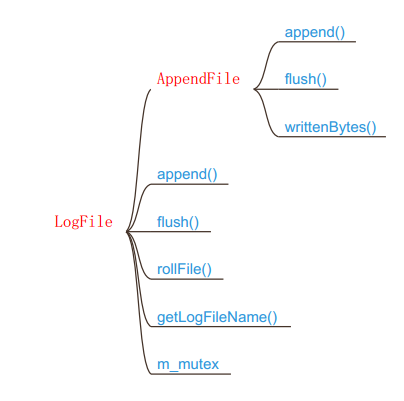
AsyncLogging类
AsyncLogging异步日志类, 完成日志的异步写入工作.
介绍它的接口前,先描述下它的工作逻辑.
AsyncLogging 有以下述几类缓存.
m_currentBuffer : 指向当前接收其他线程append过来的日志的缓存.
m_buffers : 用于存放当前已写满或过了冲刷周期的日志缓存的指针容器.
m_nextBuffer : 指向当m_currentBuffer满后用于替代m_currentBuffer的缓存.
backupBuffer1 : 备用缓存.
backupBuffer2 : 备用缓存.
buffersToWrite : 和m_buffers通过交换swap()后append()到LogFile的指针容器.
AsyncLogging 使用的双缓冲机制 有两个缓存容器 : m_buffers 、buffersToWrite 交替使用 . 一下我们简称为 A 和 B .
A 用于接收 其他线程 append() 进来的日志.
B 用于将目前已接受的缓存 写入 日志文件. 当B写完时 , clean() B , 交换A,B,如此往复.
优点 : 新建的日志不必等待磁盘操作,也避免了每条新日志都触发日志线程,而是将多条日志拼程一个大的buffer 传送给日志线程写入文件. 相当于批处理, 减少线程唤醒频率 ,降低开销。
另外 ,为了及时将 日志消息写入文件, 即是 buffer A 中还没有push进来日志 也会每三秒 执行一次上述的写入操作.
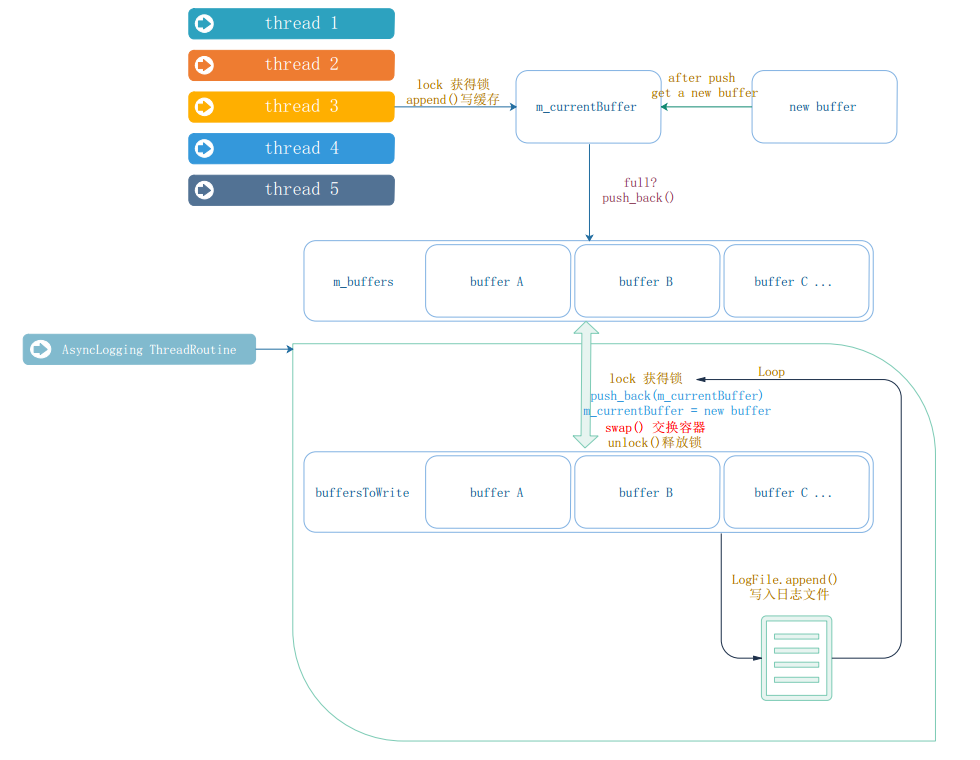
AsyncLogging使用一个更大的LogBuffer来保存一条条Logger传送过来的日志.
Mutex :用来控制多线程的写入.
Condition : 用来等待缓冲区中的数据.
Thread : 使用一个线程处理缓存的交换,以及日志的写入.
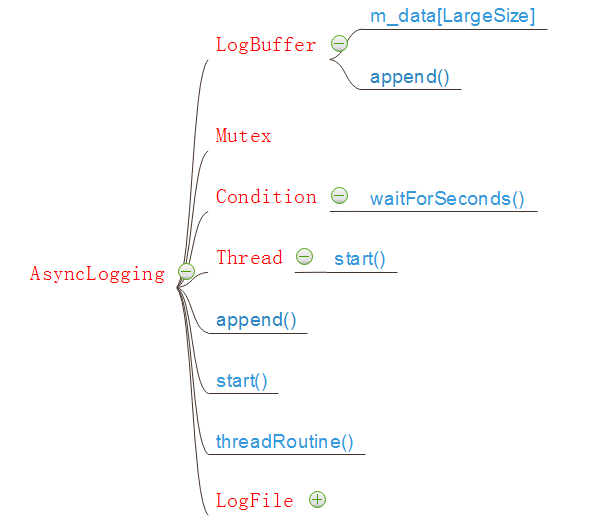
AsyncLogging实现
下面会给出AsyncLogging的简单实现.
实际上还有几个备用缓存,这里没有加上去,以便于理解程序; 备用缓存主要是为了减少反复new 操作带来的系统开销,
#ifndef _ASYNC_LOGGING_HH
#define _ASYNC_LOGGING_HH
#include "MutexLock.hh"
#include "Thread.hh"
#include "LogStream.hh"
#include "ptr_vector.hh"
#include "Condition.hh"
#include <string>
class AsyncLogging
{
public:
AsyncLogging(const std::string filePath, off_t rollSize, int flushInterval = 3);
~AsyncLogging();
void start(){
m_isRunning = true;
m_thread.start();
}
void stop(){
m_isRunning = false;
m_cond.notify();
}
void append(const char *logline, int len);
private:
AsyncLogging(const AsyncLogging&);
AsyncLogging& operator=(const AsyncLogging&);
void threadRoutine();
typedef LogBuffer<kLargeBuffer> Buffer;
typedef oneself::ptr_vector<Buffer> BufferVector;
typedef oneself::auto_ptr<Buffer> BufferPtr;
const int m_flushInterval;
bool m_isRunning;
off_t m_rollSize;
std::string m_filePath;
Thread m_thread;
MutexLock m_mutex;
Condition m_cond;
BufferPtr m_currentBuffer;
BufferVector m_buffers;
};
#endif
//AsyncLogging.cpp
#include "AsyncLogging.hh"
#include "LogFile.hh"
#include <assert.h>
#include <stdio.h>
AsyncLogging::AsyncLogging(const std::string filePath, off_t rollSize, int flushInterval)
:m_filePath(filePath),
m_rollSize(2048),
m_flushInterval(flushInterval),
m_isRunning(false),
m_thread(std::bind(&AsyncLogging::threadRoutine, this)),
m_mutex(),
m_cond(m_mutex),
m_currentBuffer(new Buffer),
m_buffers()
{
}
AsyncLogging::~AsyncLogging(){
if(m_isRunning) stop();
}
void AsyncLogging::append(const char* logline, int len){
MutexLockGuard lock(m_mutex);
if(m_currentBuffer->avail() > len){
m_currentBuffer->append(logline, len);
}
else{
m_buffers.push_back(m_currentBuffer.release());
m_currentBuffer.reset(new Buffer);
m_currentBuffer->append(logline, len);
m_cond.notify();
}
}
void AsyncLogging::threadRoutine(){
assert(m_isRunning == true);
LogFile output(m_filePath, m_rollSize, false);
BufferVector buffersToWrite;
buffersToWrite.reserve(8);
while(m_isRunning){
assert(buffersToWrite.empty());
{
MutexLockGuard lock(m_mutex);
if(m_buffers.empty()){
m_cond.waitForSeconds(m_flushInterval);
}
m_buffers.push_back(m_currentBuffer.release());
m_currentBuffer.reset(new Buffer);
m_buffers.swap(buffersToWrite);
}
assert(!buffersToWrite.empty());
for(size_t i = 0; i < buffersToWrite.size(); ++i){
output.append(buffersToWrite[i]->data(), buffersToWrite[i]->length());
}
buffersToWrite.clear();
output.flush();
}
output.flush();
}
增加备用缓存
增加备用缓存优化上面程序,上面程序一共在两个地方执行了new操作.
1.m_currentBuffer 填满时,需要把它填进容器的时候.
2.到时间了需要把m_currentBuffer里面的内容写入本地文件时,会把它当前的内容移出来,这时候需要new一个新缓存来给m_currentBuffer.
于是我们准备一个m_nextBuffer来做m_currentBuffer的备用缓存.同时在线程中增加两个backupBuffer 给m_nextBuffer 当备用缓存;当日志量大到不够用的时候, 再考虑用new 操作来动态添加缓存。
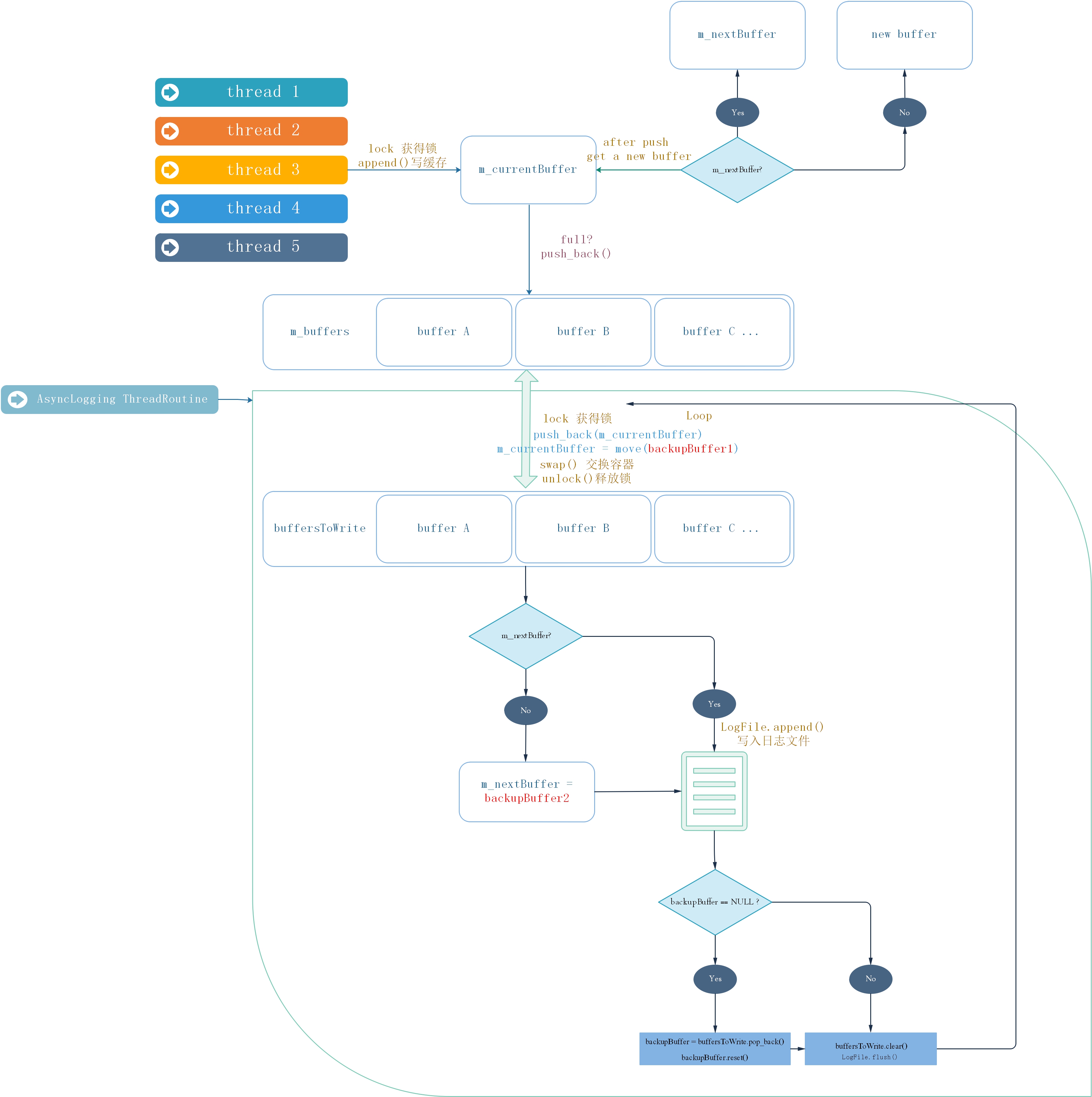
#ifndef _ASYNC_LOGGING_HH
#define _ASYNC_LOGGING_HH
#include "MutexLock.hh"
#include "Thread.hh"
#include "LogStream.hh"
#include "ptr_vector.hh"
#include "Condition.hh"
#include <memory>
#include <string>
class AsyncLogging
{
public:
AsyncLogging(const std::string filePath, off_t rollSize, int flushInterval = 3);
~AsyncLogging();
void start(){
m_isRunning = true;
m_thread.start();
}
void stop(){
m_isRunning = false;
m_cond.notify();
}
void append(const char *logline, int len);
private:
AsyncLogging(const AsyncLogging&);
AsyncLogging& operator=(const AsyncLogging&);
void threadRoutine();
typedef LogBuffer<kLargeBuffer> Buffer;
typedef myself::ptr_vector<Buffer> BufferVector;
typedef std::unique_ptr<Buffer> BufferPtr;
const int m_flushInterval;
bool m_isRunning;
off_t m_rollSize;
std::string m_filePath;
Thread m_thread;
MutexLock m_mutex;
Condition m_cond;
BufferPtr m_currentBuffer;
BufferPtr m_nextBuffer;
BufferVector m_buffers;
};
#endif
//AsynvLogging.cpp
#include "AsyncLogging.hh"
#include "LogFile.hh"
#include <assert.h>
#include <stdio.h>
AsyncLogging::AsyncLogging(const std::string filePath, off_t rollSize, int flushInterval)
:m_filePath(filePath),
m_rollSize(rollSize),
m_flushInterval(flushInterval),
m_isRunning(false),
m_thread(std::bind(&AsyncLogging::threadRoutine, this)),
m_mutex(),
m_cond(m_mutex),
m_currentBuffer(new Buffer),
m_nextBuffer(new Buffer),
m_buffers()
{
}
AsyncLogging::~AsyncLogging(){
if(m_isRunning) stop();
}
void AsyncLogging::append(const char* logline, int len){
MutexLockGuard lock(m_mutex);
if(m_currentBuffer->avail() > len){
m_currentBuffer->append(logline, len);
}
else{
m_buffers.push_back(m_currentBuffer.release());
if(m_nextBuffer){
m_currentBuffer = std::move(m_nextBuffer);
}
else{
m_currentBuffer.reset(new Buffer);
}
m_currentBuffer->append(logline, len);
m_cond.notify();
}
}
void AsyncLogging::threadRoutine(){
assert(m_isRunning == true);
LogFile output(m_filePath, m_rollSize, false);
BufferPtr backupBuffer1(new Buffer);
BufferPtr backupBuffer2(new Buffer);
BufferVector buffersToWrite;
buffersToWrite.reserve(8);
while(m_isRunning){
assert(buffersToWrite.empty());
{
MutexLockGuard lock(m_mutex);
if(m_buffers.empty()){
m_cond.waitForSeconds(m_flushInterval);
}
m_buffers.push_back(m_currentBuffer.release());
m_currentBuffer = std::move(backupBuffer1);
m_buffers.swap(buffersToWrite);
if(!m_nextBuffer)
m_nextBuffer = std::move(backupBuffer2);
}
assert(!buffersToWrite.empty());
for(size_t i = 0; i < buffersToWrite.size(); ++i){
output.append(buffersToWrite[i]->data(), buffersToWrite[i]->length());
}
if(buffersToWrite.size() > 2)
{
// drop non-bzero-ed buffers, avoid trashing
buffersToWrite.resize(2);
}
if(!backupBuffer1)
{
assert(!buffersToWrite.empty());
backupBuffer1 = std::move(buffersToWrite.pop_back());
backupBuffer1->reset();
}
if(!backupBuffer2)
{
assert(!buffersToWrite.empty());
backupBuffer2 = std::move(buffersToWrite.pop_back());
backupBuffer2->reset();
}
buffersToWrite.clear();
output.flush();
}
output.flush();
}
结语
本文主要介绍了muduo中AsyncLogging类的实现,其中的双缓存机制.
LogFile类及AppendFIle类 分别是日志文件管理类和本地文件的基本操作类. 不难理解,感兴趣的话可以看看muduo的源码,本文不再往下写了,如果想要全部源码可以留言。
最新源码:
https://github.com/BethlyRoseDaisley/SimpleMuduo/tree/master/AsyncLogging
一个轻巧高效的多线程c++stream风格异步日志(二)的更多相关文章
- 一个轻巧高效的多线程c++stream风格异步日志(一)
一个轻巧高效的多线程c++stream风格异步日志 一个轻巧高效的多线程c++stream风格异步日志 前言 功能需求 性能需求 Logger实现 LogStream类 Logger类 LogStre ...
- WaitForSingleObject与WaitForMultipleObjects用法详解(好用,而且进入一个非常高效沉睡状态,只占用极少的CPU时间片)
在多线程下面,有时候会希望等待某一线程完成了再继续做其他事情,要实现这个目的,可以使用Windows API函数WaitForSingleObject,或者WaitForMultipleObjects ...
- [转]一个简单的Linux多线程例子 带你洞悉互斥量 信号量 条件变量编程
一个简单的Linux多线程例子 带你洞悉互斥量 信号量 条件变量编程 希望此文能给初学多线程编程的朋友带来帮助,也希望牛人多多指出错误. 另外感谢以下链接的作者给予,给我的学习带来了很大帮助 http ...
- (转)log4j(四)——如何控制不同风格的日志信息的输出?
一:测试环境与log4j(一)——为什么要使用log4j?一样,这里不再重述 1 老规矩,先来个栗子,然后再聊聊感受 import org.apache.log4j.*; //by godtrue p ...
- python 多进程/多线程/协程 同步异步
这篇主要是对概念的理解: 1.异步和多线程区别:二者不是一个同等关系,异步是最终目的,多线程只是我们实现异步的一种手段.异步是当一个调用请求发送给被调用者,而调用者不用等待其结果的返回而可以做其它的事 ...
- log4j(四)——如何控制不同风格的日志信息的输出?
一:测试环境与log4j(一)——为什么要使用log4j?一样,这里不再重述 二:老规矩,先来个栗子,然后再聊聊感受 import org.apache.log4j.*; //by godtrue p ...
- Java8新特性 Stream流式思想(二)
如何获取Stream流刚开始写博客,有一些不到位的地方,还请各位论坛大佬见谅,谢谢! package cn.com.zq.demo01.Stream.test01.Stream; import org ...
- 写一个Windows上的守护进程(4)日志其余
写一个Windows上的守护进程(4)日志其余 这次把和日志相关的其他东西一并说了. 一.vaformat C++日志接口通常有两种形式:流输入形式,printf形式. 我采用printf形式,因为流 ...
- Prism for WPF 搭建一个简单的模块化开发框架(四)异步调用WCF服务、WCF消息头添加安全验证Token
原文:Prism for WPF 搭建一个简单的模块化开发框架(四)异步调用WCF服务.WCF消息头添加安全验证Token 为什么选择wcf? 因为好像wcf和wpf就是哥俩,,, 为什么选择异步 ...
随机推荐
- [学习笔记]nim游戏
普通nim游戏: n堆石子,每个人每次对着一堆拿若干个.不能拿者判输. 只有两种情况,先手必胜,先手必败. 先手必胜当且仅当:a1^a2^...^an!=0 证明: 设=x(x不为0),选择最高位和x ...
- 关于xmlhttp会使用ie的缓存的问题及解决
在浏览器(如:IE)的客户端使用xmlhttp读取网络资源的时候,需要考虑到浏览器本地缓存的问题. 如果希望读取的数据是实时更新的,也就是不想从本地缓存中读取数据,我之前常用的方法是在请求网址后面加一 ...
- 图形化调试工具DDD
ubuntu安装DDD: sudo apt-get install ddd If you still need to compile it for some reason you should be ...
- (转)flask的context机制
本文转自:https://blog.tonyseek.com/post/the-context-mechanism-of-flask/ 作者:无知的 TonySeek 注意:本文仅仅作为个人mark, ...
- 安装【Jenkins】
前言 jenkins的一款持续集成工具, 它可以做的事情很多,其中一个主要的功能就是简化部署流程 回想一下我们的发布流程: 1.本地把项目打包 ...
- Java基础-零拷贝技术应用案例
Java基础-零拷贝技术应用案例 作者:尹正杰 版权声明:原创作品,谢绝转载!否则将追究法律责任. 零拷贝技术在Hadoop生态圈中很多组件得到应用,典型的比如kafka组件,它就很成功的应用了零拷贝 ...
- Linux 命令详解(一)export 命令
一.Windows 环境变量 1.在Windows 系统下,很多软件安装都需要配置环境变量,比如 安装 jdk ,如果不配置环境变量,在非软件安装的目录下运行javac 命令,将会报告找不到文件,类似 ...
- Java入门系列(八)多线程
基本线程类指的是Thread类,Runnable接口,Callable接口 典型多线程问题 生产者-消费者 死锁问题
- 关于aspx.designer.cs
.aspx文件..aspx.cs文件和.aspx.designer.cs的一些说明 .aspx文件:(页面)书写页面代码.存储的是页面design代码.只是放各个控件的代码,处理代码一般放在.cs文件 ...
- XMPP用户登录
CHENYILONG Blog XMPP用户登录 技术博客http://www.cnblogs.com/ChenYilong/ 新浪微博http://weibo.com/luohanchenyilon ...
